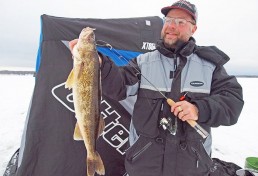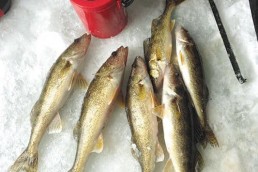Search Structure to Locate Late-ice Walleyes
SHARE THIS POST
The month of March is most certainly a time of seasonal transition throughout the Midwest. Apart from the rogue storm that can roll through, most of the heavy snows have stopped falling, the days are warming and the amount of daylight is noticeably elongated.
Overall, these are the triggers that make walleyes less lethargic than they were during mid-winter, and they are now on the move under the slowly decaying ice, if it’s not already gone.
If you follow the travels of walleyes during last ice you’ll catch more fish, no matter the techniques you choose. Even more cool, this is the time of year you might just land the biggest walleye of your life.
The reason for the late ice season
Now more than ever, walleyes are found in such tightly knit packs. This is because these springtime spawners are schooling up and making massive migrations, heading towards the very areas they will lay eggs and emit milt.
Even in waterways where natural reproduction is limited or nonexistent, walleyes will at least go through the motions of procreating. This will happen upon most any structure. However, their preference will be to breed in areas with small rocks and/or gravel, even more so if there is water rushing over them such as in rivers and streams. Weeds, too, as well sandy bottoms vicinities will do.
Look nearby
Now the fish aren’t ready to spawn just quite yet. (The act, more than likely, takes place during open water right after ice-out, when temperatures reach the low 40s, and especially when a full moon is the phase). This means you should be targeting areas near spawning location, not on them, right now.
Generally, I look for steep breaklines in close proximity to where the hanky-panky will commence, or fish as close to the inlets of rivers and streams as safe ice will allow. And these breaklines are easy to find with the use of modern-day GPS.
At my ready at all times on the ice is an Elite-5 Ice Machine by Lowrance. Within the unit’s card reader is an SD card filled with hydrographic maps by Navionics. With it in GPS mode and the Navionics mapping showing in the background, I am able to locate and drill holes precisely over breaklines with ease. When I switch the unit over to sonar mode, I not only can see fish that might be swimming below me, but can spy my jig and be able to move it up or down in the water column and right into the faces of the passersby.
The water depths I look for will vary depending on the waterway I am fishing. In some cases, I may only be fishing the outside (deeper) edge of a breakline in 6 to 10 feet, while other times the water will be in the teens. The most important factor, precedence over depth, is to make sure I am as close to the actual breakline as possible. If there are any still-green weeds in the area, as well wood or rock, I’ll fish as close to those as I can.
How do I know I’m fishing close by structure if it’s not right under me? Why with a MarCum underwater viewing system, of course.
To this day, I still use my MarCum VS825SD color underwater camera for gathering information about what’s laying outside my sonars transducer signal, including watching fish. New this year is the company’s PanCam camera system, which works remotely via Wi-Fi from your smartphone or tablet. It’s very cool, to say the least.
And before dropping my first lure through a hole in the ice, I make sure to bore as many as I can with my StrikeMaster power auger, so as to make all my commotion at once. This allows the environment below the ice to settle down as the morning progresses. And how many holes, you ask? Up to two dozen if the area is large enough.
Are you enjoying this post?
You can be among the first to get the latest info on where to go, what to use and how to use it!
Tie one on
Once all my holes are drilled, I’ll check the depth as well any sign of fish with my Lowrance. If fish are spotted, I’ll immediately drop down a heavy lure tipped with either the head or tail section of a minnow fresh from my bait container, or, with a Berkley Gulp Minnow Head.
My favorite jigs by far are the 5- and 7-inch Jigging Raps and Rapala Jigging Shad Raps. When tipping the lure, I do so to the treble hook dangling from the lure’s belly so as not to impede the action.
I’ll decide which one to tie on first depending on the baitfish in the system I am fishing. If wide-bodied preys such as panfish or shad are present, I use the fat-body-shaped Jigging Shad Rap; if long, slender baitfishes are the norm and I’ll use the narrow-bodied Jigging Rap.
Large spoons in 1/2- and 3/4-ounce weights will work wonders this time of year, as well. In clear water, plain silver, gold and copper are great color choices. In stained, bright colors and lures with rattles will get tied on.
When fishing either style of lure and I am not marking fish on my Lowrance, I’ll jig aggressively with 10- to 12-inch quick lifts and drops of my rod’s tip so as to draw attention to the bait from fish that might be swimming afar. Sometimes I’ll also lower the lure until it hits bottom, and then hop it up and down, which will rile up the lake floor.
Once fish show up, I’ll quickly reduce the amount of action I present to the lure, giving it a few short up and down strokes of only an inch or so, or, will just wiggle the end of the rod, which will cause the lure to have a nervous vibrating motion.
When jigging walleyes, I like to use a medium-action ice rod, which I couple with a spinning reel. Spooled onto the reel is 8-pound-test Berkley FireLine Micro Ice, a line that has nearly zero stretch, making it very sensitive.
To the end of the FireLine, I’ll connect a 12-inch leader of 8-pound-test Trilene 100 percent fluoro professional grade line, which I attach to the FireLine with via a small Berkley Ball-Bearing Swivel. To the other end, I’ll tie on a Berkley Cross-Loc snap (not snap swivel) in which to fix the lure.
All in all
Catching late-ice walleyes is more about knowing what it is the walleyes will be doing after ice out than anything else. That’s right, spawning.
By late winter the fish are on the move, heading toward breeding areas. This time of year they can be found along the breaklines very nearby. Drill lots of holes, and change out lures often. Most of all, hang on to that rod tight; this is the time of year you could be hooking into the biggest fish of your life.
Mark Martin is a touring walleye tournament pro and instructor with the Ice-Fishing Vacation/School, who lives in southwestern Lower Michigan. Visit his website at markmartins.net for more information about Mark, the school as well links to the products in this article.
MWO
SHARE THIS POST
Did you enjoy this post?
You can be among the first to get the latest info on where to go, what to use and how to use it!
Mark Martin
Mark Martin is a professional walleye tournament angler and instructor with the Ice Fishing School/Vacation series. For more information, check out his website at markmartins.net or fishingvacationschool.com.



